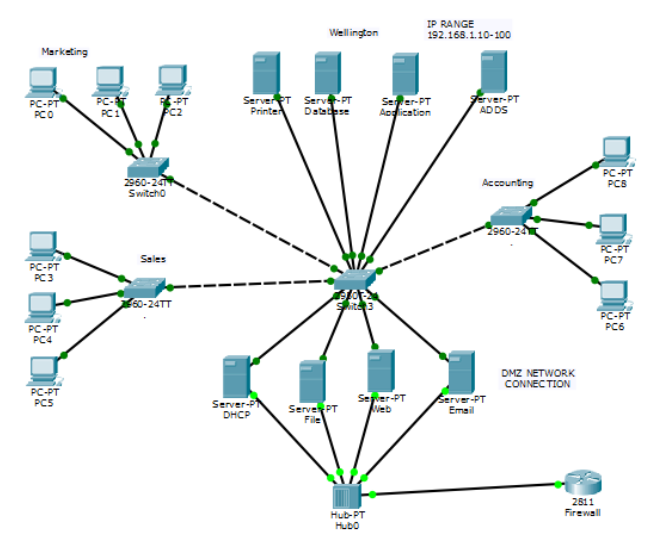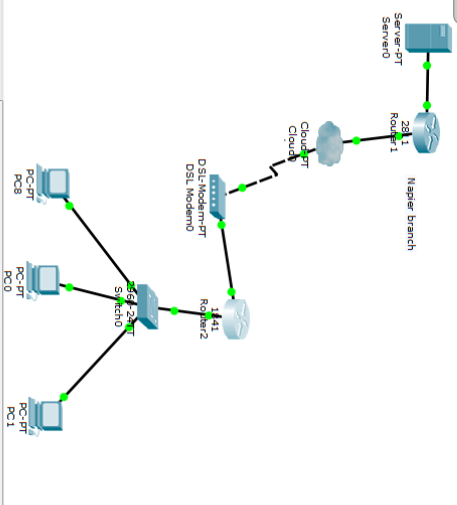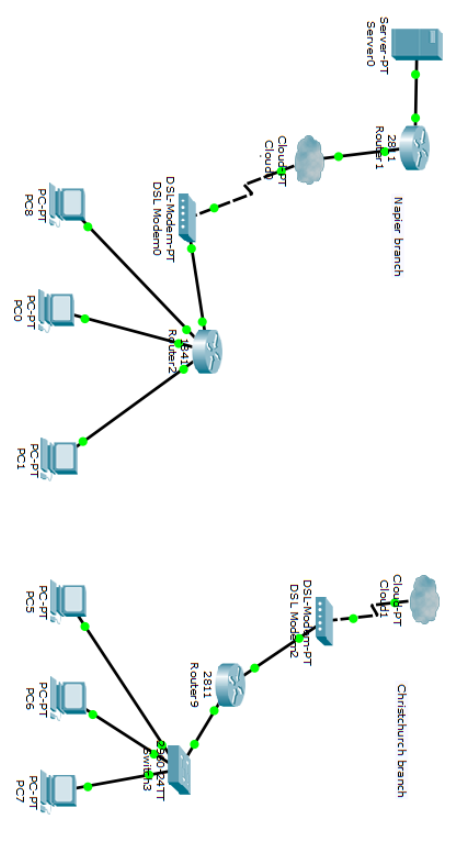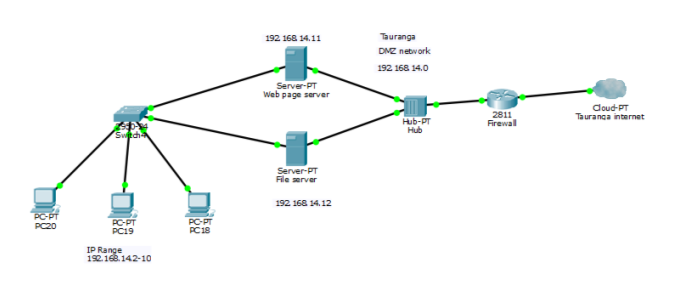Factors for Wide Area Computer Network
AWI International Education Group
Task 1/A
-
 Wellington
Wellington
-
 Napier and Christchurch:
Napier and Christchurch:
3) Auckland

- Tauranga

Task 1/B
|
Wellington |
Christchurch |
Napier |
Auckland |
Tauranga |
|
|
Local IP range |
192.168.10.0 /24 |
192.168.8.0 /24 |
192.169.19.0 /24 |
192.168.11.0 /24 |
192.168.14.0 /24 |
|
Internet IP |
122.11.80.13 |
122.11.80.14 |
122.11.80.16 |
122.13.58.4 |
122.11.80.18 |
|
DMZ IP range |
10.51.0.0 |
10.51.0.2 |
Task 1/C: Components & configurations:
|
Wellington |
|
|
Component |
Configuration |
|
LAN port each / DHCP on |
|
24 port switch |
|
|
|
1 LAN port |
|
5 LAN ports |
|
Christchurch |
|
|
LAN port |
|
6 LAN ports |
|
2x LAN ports |
|
1x LAN port & 1x RG11 |
|
Napier |
|
|
LAN port |
|
9x LAN ports |
|
2x LAN ports |
|
1x LAN port & 1x RG11 |
|
Auckland |
|
|
12x with LAN port 6x with WMP300N modules |
|
14x LAN port |
|
1x LAN port for switch (12 PCs) and wireless for 6 PCs |
|
2x LAN ports |
|
Tauranga |
|
|
LAN port |
|
7 LAN ports |
|
2x LAN ports |
|
2 LAN port |
|
2 LAN port |
Task 1/D:
- Main office of the company Printer&Printer Inc. Is located in Wellington. The office has total 52 PCs which are allocated between three major departments: Sales, Accounting and Marketing. Each department’s computers are connected via cables to Switches, which in turn are connected to the central Switch for further connection. Central Switch is also connected to 8 Servers that provide all necessary services for the network. However the main connection to the internet is provided via DMZ connection network – in face of four servers (DHCP, File, Web, Email) which are also connected to the hub. The hub in turn is connected Router which also acts as Firewall in the internet connection.
- Napier and Christchurch have similar networks, as both are connected to internet via ADSL technology. And both are connected to main office via router-to-router VPN connection. In order to create ADSL supported network, it is required to have DSL Modem, which can be connected to internet via landline cord. In turn, Modem is connected to Router in order to delegate internet to the users via Switch, which is connected to the PCs. In addition to that, one of Napier PCs are configured to establish VPN connection.
- Auckland branch. This network has 18 PCs in three floors. 12 PCs are connected to the network via Switch directly by cables. Meanwhile, third floor’s 6 PCs are connected to Switch via intermediary Wireless Router with help of WMP300N module. Switch in its turn allows to connect to the public networks (Internet). This may be arguable to have two routers instead of one, but I believe that additional Wireless Router will provide more stable and constructive connection.
- Tauranga. The network, has been established with DMZ connection starting with properly configured Firewall/Router in order to work with several IP addresses. Router is connected to Hub. Hub is connected to Servers which are used for proper services performances, which in turn are connected to the Switch, that connects PCs to the network.
Task 1/E.
All of the branches are set to be connected to the main office with the use of VPN. All VPN connections from branches to the main office are connected to the Firewall. Firewall in turn, is configured with all the restrictions and access policies. As is written in scenario, the branch can connect to the main office via on-demand router-to-router VPN connections. On the other hand, as given example with Auckland branch, it can connect to main office, by “persistent VPN connections that stay connected 24/7”.
Task1/F.
In case of the Partners, they can connect to the main office network via VPN connection. But in common cases they use Cisco VPN utility that contain SSL certificate, IP address, password. Meanwhile Firewall is configured with identification of these IP addresses, based on which certain access level is delegated for the partners.
Task 2/A.
In case of main office, DHCP, File, Web and Email servers have static IP addresses which route 10.51.0.0 network and 192.168.14.0.
In Napier branch Router2 has default routing. As well as Christchurch branch.
In Auckland branch, we face the same case of both Routers to have default routing.
Finally, in case of Tauranga, Web and File servers, also have static IP addresses which route 10.51.0.0 network and 192.168.10.0.
Task 2/B.
For t Static routing tables were used to configure the networks. In addition to that, default routing was implemented in all routers. To ensure correct work, tracert command was used in command prompt.
Bibliography
Requirements for IPv4 Routers, F. Baker, RFC 1812, June 1995
Ingress Filtering for Multihomed Networks,RFC 3704, F. Baker & P. Savola,March 2004